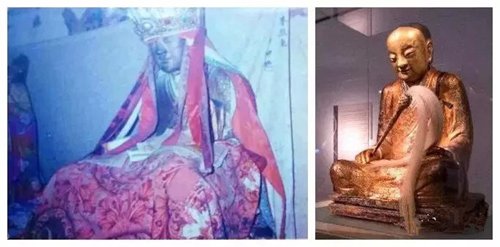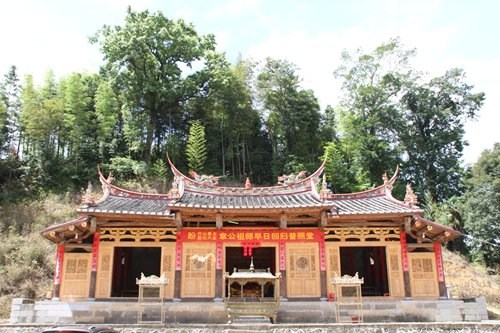
A picture of the stolen Buddha (left) and the picture of the Buddha on display at Hungarian Natural History Museum in Budapest (Photos/Courtesy of Lin Wenqing)

Yangchun village temple where the Buddha statue was originally placed (Photo/Courtesy of Lin Wenqing)
The legal battle between Dutch art collector Oscar van Overeem and Yangchun villagers from East China's Fujian Province has made progress.
The Dutch court has ordered the plaintiffs, Yangchun villagers, to provide a guaranteed court fee of 2,879 euros (about $3,189) and the defendant, Dutch art collector van Overeem, to submit a notice of response no later than November 23, 2016, Chinese media reported.
According to the Dutch law, the statute of limitation for this type of lawsuit is 20 years. The Buddha was said to be stolen at the end of 1995; however van Overeem claimed that he acquired it in 1996 from a Hong Kong art dealer, which left the Fujian villagers with very little time to take legal action, media reports said.
"We are preparing the money right now, it's not a big sum and it's good that there is a deadline for the Dutch art collector to respond to the notice, which he has already postponed twice, the first time he requested a delay of six weeks and the second time four weeks. We know that he is trying to buy time for gathering more legal evidence on his part," Lin Wenqing, a spokesperson for the villagers, told the Global Times Wednesday.
Legal battle
The case was taken to court in Netherlands by a group of volunteer lawyers, including a Dutch lawyer, in June this year, after van Overeem refused to return the Buddha to Yangchun villagers. However it was reported that he would consider to return the Buddha, "if it is proven to have belonged to a Buddhist community that still exists," and then he expressed his willingness to return the Buddha to South Putuo Temple in Xiamen, Fujian Province as it had better facilities instead of the humble village temple.
But his offer was declined by the South Putuo Temple on the grounds of differences in religious beliefs.
Later he changed his mind again by asking a price of $20 million to $30 million for the statue from the Chinese government as compensation, the Xinhua News Agency and Britain's Daily Mail reported.
"His attitude is very ambiguous. We sincerely wish he can return the Buddha to us without going to the court. We know that in the past 20 years he has taken very good care of the Buddha, which our villagers truly appreciate. For us, the Buddha is like a family, we love and worship it so much that no matter how difficult it is going to be, we are determined to get it back. We do not want to take legal action against somebody who is actually our benefactor," Lin Wenqing told the Global Times.
The golden sitting Buddha, which contains the remains of a monk who lived in China's Northern Song Dynasty (960-1127), is about four-foot (1.2 meters) tall. According to the villagers, this Buddha had been placed at the Yangchun village temple for more than 1,000 years and local worshippers called him Zhanggong Zushi and treated him like a god over the centuries. Legend had it that when he was still alive, he devoted all his life to helping and treating sick villagers with herbs, and when he died aged 37, he turned himself into a mummy and his body was placed inside the statue about 200 years later.
Contentious treasure
In December 1995, the Buddha was found to have disappeared from its seat.
Lin Wenqing said a man called Lin Guangming, a brick worker who was working close to the temple, witnessed the theft. He told the villagers he saw a minivan around the temple that night, and when the van left, he even helped to move the bricks out of the way. Twenty years ago, cars and vans were very rare to see, so that minivan caught his attention. He peeked inside the window and saw something being covered by a blanket, which looked like a sick person.
In the following 20 years, villagers have been relentlessly looking for the Buddha but nothing was found.
However in March 2015, an exhibition called "Mummy World" was held in Hungarian Natural History Museum, Budapest and the centerpiece of the exhibition was a golden sitting mummified Buddha which looked exactly the same as the stolen one from Yangchun village.
"There is a Fujian businessman who lives in Budapest, he is actually from our village, and he is very familiar with the Buddha. When he first saw the photo of the exhibited Buddha in media, he immediately recognized it's the stolen one. And from a reporter of the New York Times, we finally got to know the current owner of the Buddha, a Dutch collector called Oscar van Overeem," Lin Wenqing said.
In 1997, van Overeem took the statue to Utrecht University to have it carbon-dated and scanned and the Dutch scientists found remains of a human body dating back to the 11th century inside the statue. In 2014, the Meander Medical Centre in Amsterdam conducted a scan on the statue, and the results showed the abdominal cavity of the body, where there had once been organs, had been taken out and there were paper scraps printed with ancient Chinese characters in it now, Reuters reported.
"To win the case, the Chinese lawyers and villagers need to gather strong and adequate historical recordings including the village genealogical books, previous pictures of the Buddha and hand-written texts. Normally it is very difficult to trace back relics which were brought to the West long time ago, for example before the 20th century, but it is relatively easy to get back the items which were lost in the contemporary period," Huo Zhengxin, an international law expert from China University of Political Science and Law, told the Global Times in a telephone interview.
"The Dutch collector may try to prove he acquired the Buddha with a goodwill and did not know the fact that the item he bought was smuggled out of China at that time. If he could prove it, then it would be very difficult for the villagers to get the Buddha back according to the Dutch law. However, the lawsuit is helpful in clarifying how this Buddha ended up in the West, because van Overeem would be obligated to respond to the lawsuit and provide evidence," Huo noted.


















































